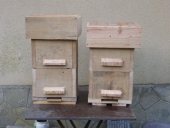For context, I meet most of the requirements for the various versions of Brown Belt outlined here except for the versions that are manipulation or sales heavy. My thoughts are that this is PEP[aul] not PEC[ommercial production]. I think that PEP standards would likely be treatment free (except feeding during initial installation, or if trauma to the colony is your own fault, i.e. a late but necessary cutout, or stupidly robbing too much honey). I don't think the type of hive should matter (since some local laws require removable frames) as long as the management style allows for the building of natural comb at the bees own preferred cell size (foundationless), along with cyclical renewal of the comb. Warrés, Japanese multi-tiered boxes or gums, and HTBHs do this automatically, and the Rose Hive method will work for Langs if you standardize on mediums or shallows. Perones or Holzer style gums might be allowed exceptions to that rule. I also suspect that PEP[aul] would prefer natural propagation, therefore no queen rearing, no splits, no shook swarms, but concentrating on recovery of swarms from one's own apiary, as well as baiting local survivor stock.
There are many traits we might select for the beekeeper's convenience (low use of propolis for example) that may actually be a disadvantage for the bees themselves. Here in Texas we have a huge problem with small hive beetle, especially when we have a warmer winter. Opening the hive less often and allowing the bees to propolize the heck out of things lets the bees manage the beetles on their own with beetle traps. Treating propolis as a nuisance, opening the hive and scraping it off (releasing trapped beetles), or selecting for "clean" bees, puts the colony at a disadvantage, requiring more input and management from the beekeeper. Almost any undesirable trait can be viewed this way, and only by allowing bees to evolve on their own can they they meet the selection pressures of an unstable environment.
The book lists look good. I second Beekeeping for All, At the Hive Entrance, and Honeybee Democracy. I think Seeley's book is a crucial read if you want to rid your head of all the dumb ideas about bees you picked up watching Saturday morning cartoons as a kid. The Sacred Bee in Ancient Times and Folklore is nice for some deep historical context, and fun for those who want a purple tinge to their brown belt.





